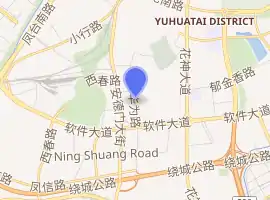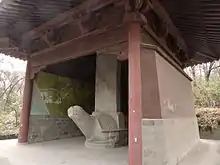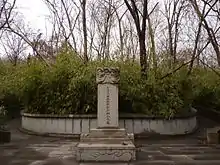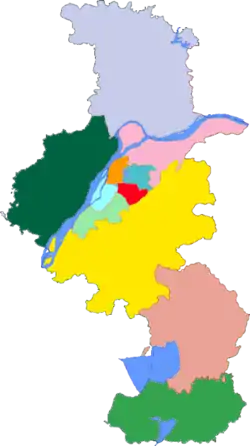Tomb of the King of Boni
The Tomb of the King of Boni is the tomb of Abdul Majid Hassan (also known as Maharaja Karna, or Ma Na Re Jia Na 麻那惹加那 in Chinese), the ruler of Boni, a medieval state on the island of Borneo sometimes considered to be the predecessor of modern Brunei. It and its associated statuary are located in a park at the southern foothills of Tortoise Mountain (Guishan), about 3 km south of the southern gate of the walled city of Nanjing.
| Tomb of the King of Boni | |
|---|---|
浡泥国王墓 | |
_Nanjing.JPG.webp) The spirit way of the Tomb of the King of Boni | |

| |
| General information | |
| Type | Tomb, spirit way statuary and stelae |
| Address | No.9, Weijiu Road of Huacun, southern foot of Mountain Tortoise |
| Town or city | Yuhuatai District, Nanjing, Jiangsu province |
| Country | China |
| Coordinates | 31.981722°N 118.760498°E |
| Completed | 15th century |
| Tomb of the King of Boni | |||||||
|---|---|---|---|---|---|---|---|
| Simplified Chinese | 浡泥国王墓 | ||||||
| |||||||
The tomb was completed in the early 15th century during the Ming Dynasty, under the reign of the Yongle Emperor. It is one of the only two foreign rulers' tombs in China (the other one being the Tomb of the King of Sulu in Dezhou, Shandong).[1][2] it is an important heritage site under state protection.
History
The country whose name is recorded in the early Ming dynasty records as "Boni" was a state in Borneo Island.[3][4] By the time of their king's arrival to Nanjing, "Boni" had had a long history of contact with China, having sent envoys during the Northern Song dynasty.[3][5]
In the third year of the Hongwu reign, Ming dynasty (1370), the emperor Zhu Yuanzhang dispatched imperial censor Zhang Jingzhi and Fujian official Shen Zhi to Boni on a diplomatic mission. On their return to China, the King of Boni sent his envoys along with the two Chinese officials.[3]
Maharaja Karna ascended to the throne in 1402, and sent his envoys to China to pay tribute to the Yongle Emperor in 1405. In return, the Emperor granted an imperial mandate and seal to the King. The King was greatly pleased and decided to express his heartfelt thanks in person. Thus he arrived in Fujian province by sea, along with his wife, sons and several other relatives, and they received a warm welcome from the local officials sent by the central government.[3][4]
Death of Karna

In August of 1408, Maharaja Karna and his companions reached the Ming Empire's capital Nanjing, to attend the imperial court. He fell ill after staying in Nanjing for over a month. He was 28 years old when he died in his residence in the tenth lunar month of that year. In his testament, he showed a desire to “be buried in China”. The Yongle Emperor suspended court for three days, dispatched officials to mourn for the King, and conferred the posthumous title of "Deferent" on him. After the Boni ruler's death, he was buried outside Andemen in Shizigang, which was in the southern part of Nanjing, according to the traditional burial customs of Chinese vassal. In addition, the Yongle Emperor ordered the king's son to succeed to his father's crown.[3][5][6]
Abandonment and rediscovery
Later, the tomb was deserted and abandoned in the forest,[7] thus gained a name of “Huihuifen” (literally the tomb of the Hui people) from the local residents. During an archaeological survey in 1958, two broken fallen steles were rediscovered.[8] According to the remaining inscriptions, the Boni king was inferred to be buried in the tomb. Afterwards, the Nanjing government carried out a series of renovations to the tomb, the gravestone, the spirit way,[9] and rebuilt the memorial archway, the spirit pavilion and the stone platform. In 1982, the Tomb of the King of Boni was listed as the important protection unit of cultural relic of Jiangsu province and it became a Key Cultural Relic Unit under State Protection in 2001. The sister of the Brunei Sultan Hassanal Bolkiah, known as Princess Masnah, visited the tomb of the King and attended the opening ceremony of the newly built “China-Brunei Friendship Hall” in 2006.[10][11][12] On 23 October 2008, the Brunei Style Park was finished. It cost ¥ 23 million[10] and Princess Masnah again attended the opening ceremony.
Architecture

The Tomb of the King of Boni faces northwards, with Niushou Mountain in the distance. There is a pool in front of it, and the tomb is surrounded by trees. Stone sculptures of generals, tigers, goats, horses and grooms are on either side of the spirit way,[9] with very exotic touches in the carving. The tomb is at the end of the path, similar to that of Sulu King. It consists of a round, central mound and is surrounded with granite. The tombstone reads, "The Tombstone of the Deferent King of Boni". The inscription records the King’s deeds, the treatment he received from the imperial court and the construction information of the tomb. It was written by Grand Secretary Hu Guang[6] and engraved by Eunuch Zhang Qian with local selected stones. As the Boni people believed in Islam, the style of the King's tomb was quite different from that in the Central Plains.
Current status
At present, the tomb and its surroundings are classed as "The Tomb of the King of Boni scenic spot", covering an area of 17 hectares. It is an AA category national tourist site which consists of three parts, namely the tomb of the King of Boni area, the Brunei Style Park and a service area.[13] The shrine, the stone portraits and the tombs are still fairly well preserved. The ruins of the gravestone have been put up again, but most of the inscription has eroded over a long period of time.[7][14] The Brunei Style Park contains the China-Brunei Friendship Hall, a mosque, the Brunei Water Garden, pavilions, side streets, labyrinths and Songfeng Palace, etc. The China-Brunei Friendship Hall contains a permanent exhibit of images and text regarding the interaction history of the two countries.
See also
| Wikimedia Commons has media related to Tomb of the Sultan of Brunei in Nanjing. |
References
- Furthermore, there is a cenotaph of King Taksin of Siam in Chenghai, Guangdong province.
- "南京城外的古浡泥国王墓(The Ancient Tomb of the King of Boni Outside Nanjing City)". 中国旅游报数字报. Retrieved 31 January 2011.
- (Qing) Zhang Tingyu (張廷玉); et al. (1974). 明史 (‘’History of Ming’’) (in Chinese). revised by Zhonghua Book Company. Beijing: Zhonghua Book Company. ISBN 7101003273.
- Johannes L. Kurz (July 2011). "Boni in Chinese Sources: Translations of Relevant Texts from the Song to the Qing Dynasties" (PDF). Nalanda-Sriwijaya Centre Working Paper Series (4). Singapore: The Nalanda-Sriwijaya Centre Institute of Southeast Asian Studies. Archived from the original (PDF) on 11 April 2012. Cite journal requires
|journal=(help) - (Ming) Yan Congjian (严从简), ed. (1993). 殊域周咨錄 (‘’The Record of General Condition of Various Foreign Countries for Consultation’’) (in Chinese). revised by Yu Sili (余思黎). Beijing: Zhonghua Book Company. ISBN 7101006078.
- Cheng Minzheng (程敏政), ed. (15th century (Ming dynasty)). "Chapter 11". 皇明文衡 (Exemplary Documents of the Ming Dynasty) (PDF). Tokyo: Chinese Materials and Rare Book Full -text-and-image Database, The Institute of Oriental Culture, University of Tokyo. Check date values in:
|date=(help) - "金陵九大古碑——"体魄托葬中华"的浡泥国王碑 (Nine Ancient Steles of Jinling – the Stele of the King of Boni Who Was Buried in China)" (in Chinese). 南京旅游预订网. Retrieved 11 April 2012.
- "南京纪念浡泥国王墓重新发现47周年(Nanjing Commemorates the 47th Anniversary of Rediscovery of Tomb of the King of Boni))". 新华网江苏频道. Retrieved 12 May 2005.
- The "spirit way" is also sometimes translated as spirit path, spirit road or tomb path. Spirit ways are usually in Chinese mausolea, lined with successions of stone statues.
- "文莱玛斯娜公主参加"文莱风情园"揭幕仪式 (Princess Masnah attended the inauguration of the Brunei Style Park)". njyhly.cn (in Chinese). 雨花旅游网. 23 October 2008. Retrieved 10 May 2009.
- "文莱公主南京拜谒古浡泥国王墓 (The Princess of Brunei Paid Her Respect to the Ancient Tomb of the King of Boni)" (in Chinese). Jiangsu China Net (中国江苏网). 6 April 2006. Retrieved 11 April 2012.
- "Bruneian Princess pays homage to tomb of ancient Bruneian king in China". People's Daily Online. 7 April 2006. Retrieved 11 April 2012.
- "浡泥国王墓风景区 (The Tomb of the King of Boni Scenic Spot)" (in Chinese). 雨花旅游网. Retrieved 11 April 2012.
- "Ancient Tomb of King of Boni Has Been Rediscovered (南京发现古代浡泥国王的墓葬)". 文物参考资料 (8): 66. 1958.
Further reading
- "南京浡泥国王墓 (the tomb of the King of Boni, Nanjing)". Jinling Library (金陵图书馆). Retrieved 14 May 2009.
